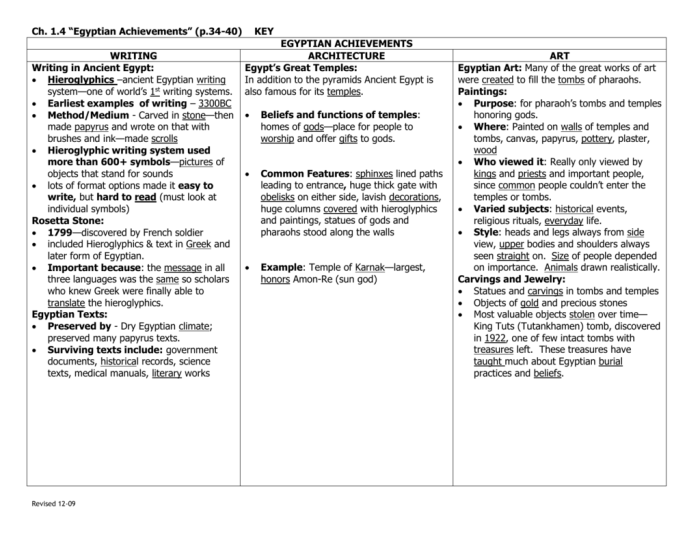Egypt Engineering an Empire Worksheet Answers embarks on an enlightening journey through the remarkable engineering feats of ancient Egypt. From the iconic pyramids and colossal temples to the ingenious irrigation systems that sustained a thriving civilization, this narrative delves into the minds and methods of the master builders who shaped the course of history.
This exploration unveils the significance of the Nile River as the lifeblood of Egyptian engineering, revealing the techniques employed to construct architectural wonders. It traces the advancements made during the New Kingdom period, showcasing the grandeur of the Valley of the Kings and its intricate design.
Moreover, it examines the profound influence of Egyptian engineering on subsequent civilizations, highlighting its enduring legacy in modern construction practices.
Ancient Egyptian Engineering: Egypt Engineering An Empire Worksheet Answers

The Nile River played a pivotal role in shaping Egyptian engineering. Its predictable flooding patterns provided a source of water for irrigation, transportation, and construction materials. The river’s fertile banks also supported agriculture, providing the resources necessary for the development of complex engineering projects.
Egyptian engineers developed advanced techniques for building pyramids and temples. They used ramps, levers, and pulleys to transport massive stone blocks and employed precise measurements and calculations to ensure the structural integrity of their constructions. The Great Pyramid of Giza, one of the Seven Wonders of the Ancient World, is a testament to their exceptional engineering skills.
Egyptian irrigation systems were crucial for agriculture. They constructed canals, dams, and reservoirs to control the flow of water and irrigate crops. These systems enabled them to cultivate fertile land and sustain a large population.
Engineering in the New Kingdom
During the New Kingdom period (c. 1550-1070 BCE), Egyptian engineering reached new heights. The construction of the Valley of the Kings, a series of elaborate underground tombs, showcases the advancements of this era. The tombs were designed with complex ventilation systems, hidden chambers, and intricate decorations, demonstrating the sophistication of Egyptian engineering.
Engineering also played a significant role in the expansion of the Egyptian empire. Engineers built roads, bridges, and fortifications to facilitate the movement of troops and the transportation of goods. Their expertise enabled Egypt to conquer and control vast territories.
Legacy of Egyptian Engineering, Egypt engineering an empire worksheet answers
Egyptian engineering had a profound influence on later civilizations. The Greeks and Romans adopted and improved upon Egyptian techniques, developing their own advanced engineering systems. The principles of Egyptian engineering, such as the use of ramps and levers, continue to be employed in modern construction practices.
The legacy of Egyptian engineering is evident in the enduring structures that have survived for centuries. The pyramids, temples, and irrigation systems of ancient Egypt stand as a testament to the ingenuity and skill of their engineers, inspiring awe and admiration in generations to come.
FAQ Summary
What were the key factors that enabled the Egyptians to construct such impressive structures?
A combination of advanced mathematical knowledge, skilled craftsmanship, and an organized workforce played a crucial role in their architectural achievements.
How did the Egyptians transport massive blocks of stone for their constructions?
They utilized ramps, sledges, and canals to move these colossal blocks, demonstrating their ingenuity and engineering prowess.
What was the purpose of the pyramids beyond serving as tombs?
Pyramids also served as symbols of royal power, religious significance, and architectural mastery, showcasing the Egyptians’ multifaceted approach to construction.
